Platinum-based antineoplastic
Platinum-based antineoplastic drugs (informally called platins) are chemotherapeutic agents used to treat cancer. They are coordination complexes of platinum. These drugs are used to treat almost half of people receiving chemotherapy for cancer. In this form of chemotherapy, popular drugs include cisplatin, oxaliplatin, and carboplatin, but several have been proposed or are under development.[1] Addition of platinum-based chemotherapy drugs to chemoradiation in women with early cervical cancer seems to improve survival and reduce risk of recurrence.[2]
In total, these drugs can cause a combination of more than 40 specific side effects which include neurotoxicity, which is manifested by peripheral neuropathies including polyneuropathy.[3]
Mechanism of action
As studied mainly on cisplatin, but presumably for other members as well, platinum-based antineoplastic agents cause crosslinking of DNA as monoadduct, interstrand crosslinks, intrastrand crosslinks or DNA protein crosslinks. Mostly they act on the adjacent N-7 position of guanine, forming a 1, 2 intrastrand crosslink.[4][5] The resultant crosslinking inhibits DNA repair and/or DNA synthesis in cancer cells.
Platinum-based antineoplastic agents are sometimes described as "alkylating-like" due to similar effects as alkylating antineoplastic agents, although they do not have an alkyl group.[6]
Examples
Strategies for improving platinum-based anticancer drugs usually involve changes in the neutral spectator ligands, which are usually nitrogenous. Changes in the nature of the anions (halides vs various carboxylates), and changes in the oxidation state of the metal (Pt(II) vs Pt(IV)). Nanotechnology has been explored to deliver platinum more efficiently in the case of Lipoplatin, which is introduced into the tumor sites thereby reducing the chance of toxicity.[7]
Cisplatin was the first to be developed.[8] Cisplatin is particularly effective against testicular cancer; the cure rate was improved from 10% to 85%.[9]
- Approved platinum-based anticancer drugs
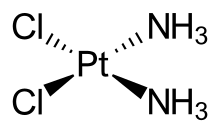
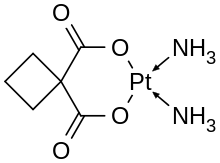
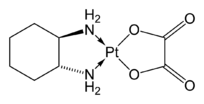
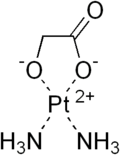
- Platinum-based anticancer drugs in trials

 Phenanthriplatin, a proposed new anticancer drug.[1]
Phenanthriplatin, a proposed new anticancer drug.[1]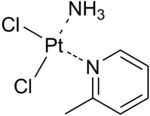 Picoplatin, which remains in trials
Picoplatin, which remains in trials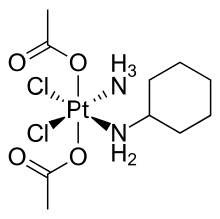
References
- Johnstone, TC; Park, GY; Lippard, SJ (2014). "Understanding and improving platinum anticancer drugs--phenanthriplatin". Anticancer Res. 34 (1): 471–6. PMC 3937549. PMID 24403503.
- Falcetta, FS; Medeiros, LR; Edelweiss, MI; Pohlmann, PR; Stein, AT; Rosa, DD (22 November 2016). "Adjuvant platinum-based chemotherapy for early stage cervical cancer". The Cochrane Database of Systematic Reviews. 11: CD005342. doi:10.1002/14651858.CD005342.pub4. PMC 4164460. PMID 27873308.
- Oun R, Moussa YE, Wheate NJ (2018). "The side effects of platinum-based chemotherapy drugs: a review for chemists". Dalton Transactions. 47 (19): 6645–6653. doi:10.1039/c8dt00838h. PMID 29632935.CS1 maint: uses authors parameter (link)
- Poklar N, Pilch DS, Lippard SJ, Redding EA, Dunham SU, Breslauer KJ (July 1996). "Influence of cisplatin intrastrand crosslinking on the conformation, thermal stability, and energetics of a 20-mer DNA duplex". Proc. Natl. Acad. Sci. U.S.A. 93 (15): 7606–11. doi:10.1073/pnas.93.15.7606. PMC 38793. PMID 8755522.
- Rudd GN, Hartley JA, Souhami RL (1995). "Persistence of cisplatin-induced DNA interstrand crosslinking in peripheral blood mononuclear cells from elderly and young individuals". Cancer Chemother. Pharmacol. 35 (4): 323–6. doi:10.1007/BF00689452. PMID 7828275.
- Cruet-Hennequart S, Glynn MT, Murillo LS, Coyne S, Carty MP (April 2008). "Enhanced DNA-PK-mediated RPA2 hyperphosphorylation in DNA polymerase eta-deficient human cells treated with cisplatin and oxaliplatin". DNA Repair (Amst.). 7 (4): 582–96. doi:10.1016/j.dnarep.2007.12.012. PMID 18289945.
- Johnstone, Timothy C.; Suntharalingam, Kogularamanan; Lippard, Stephen J. (2016). "The Next Generation of Platinum Drugs: Targeted Pt(II) Agents, Nanoparticle Delivery, and Pt(IV) Prodrugs". Chemical Reviews. 116 (5): 3436–3486. doi:10.1021/acs.chemrev.5b00597. ISSN 0009-2665. PMC 4792284. PMID 26865551.
- Kelland, L. (2007). "The resurgence of platinum-based cancer chemotherapy". Nature Reviews Cancer. 7 (8): 573–584. doi:10.1038/nrc2167. PMID 17625587.
- Einhorn LH. (1 November 1990). "Treatment of testicular cancer: a new and improved model". J. Clin. Oncol. 8 (11): 1777–81. doi:10.1200/JCO.1990.8.11.1777. PMID 1700077.